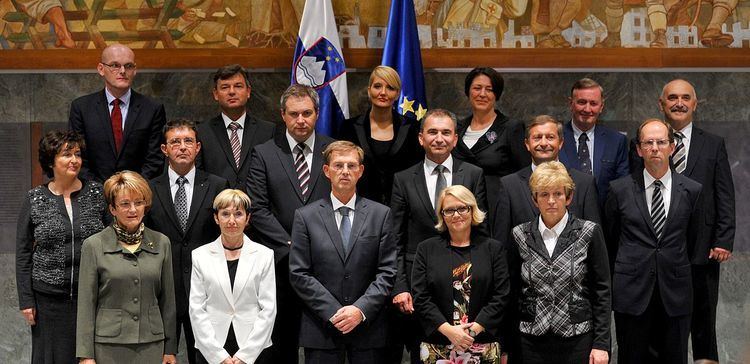The Cabinet of Prime Minister Miro Cerar was announced on 18 September 2014. It is the 12th cabinet of Slovenia, third in the last four years. It has been formed following the Slovenian parliamentary election, 2014 won by the centre-left Party of Miro Cerar. With 51 years Cerar was the second oldest Slovenian prime minister since Slovenian independence, following Andrej Bajuk with 56 years. The cabinet had on the day of inauguration the highest number of women ministers representatives, as there were seven women minsters out of sixteen ministers in total. Cerar's cabinet is the highest educated cabinet to date, with six members with doctorate.
After the resignation of the Cabinet of Alenka Bratušek, the president Borut Pahor determined that the new elections are goint to take place on 13 July 2014. With 34,49% Cerar won by the highest percentage on any parliamentary elections since the independence. The new mandatary decided not to cooperate with Slovenian Democratic Party (SDS), as their leader Janez Janša was sentenced to two years imprisonment. On 28 July 2014 Cerar sent an outline of the coalition agreement to all other parties that attended the coalition talks. The first to agree was the president of Democratic Party of Pensioners of Slovenia Karel Erjavec, with whoom Cerar gathered the necessary 45+ seats in the parliament. The next and also the last to join the coalition was Dejan Židan with his Social Democrats party. The Coalition agreement was signed on 3 September 2014.
Cabinet members came from three parties of the new coalition:
Party of Miro Cerar (SMC) - 8 Ministers + 1 Minister without portfolio
Democratic Party of Pensioners of Slovenia (DeSUS) - 3 Ministers + 1 Minister without portfolio
Social Democrats (SD) - 3 Ministers
The number of ministries rose to 16, up from 13 in the preceding Cabinet of Alenka Bratušek. Anja Kopač Mrak, Gorazd Žmavc, Dejan Židan and Karel Erjavec have retained their position.
Ministry without Portfolio responsible for Development, Strategic Projects and Cohesion was added on the list of ministries without portfolio. With this change, the number of ministries without portfolio rose to two.
The position of the Vice president of the government was renewed after 14 years, when Marjan Podobnik was the last to hold it. Cerar named three vice presidents.
Ministry of Interior and Public Administration was divided on two ministries: Ministry of Interior and Ministry of Public Administration.
Minister of Infrastructure and Urban Planning was also divided on two departments: Ministry of Infrastructure and newly formed (already existent in some previous governments) Ministry of Environment and Spatial Planning.
On 18 October 2014, the minister of economy, Jožef Petrovič, resigned and was the first minister to do so in the new government. He resigned just after one month in position because of suspicion of wrongdoing when he worked at a company that was rigging prices when dealing with the state. As he stated he resigned "to enable the government to work in peace in these troubled times". The next candidate was supposed to be Gojko Koprivec but he backed down as a candidate when he got seriously ill just one day before the interrogation. After almost 2 monts of vacancy, Slovenia got a new minister of economy. On December 4, 2014, the director of Spa Olimia Zdravko Počivalšek replaced the ex-minister of economy Jožef Petrovič.
On 10 October 2014 after Alenka Bratušek failed as a new European Commissioner designate, Slovenia named a new candidate. Minister without Portfolio responsible for Development, Strategic Projects and Cohesion Violeta Bulc was sent to Brussles where she was confirmed as a new European Commissioner for Transport. With her appointment, the ministry became vacant. Cerar named Alenka Smerkolj as a new candidate. She was confirmed on 19 November 2014.
On 6 March 2014 Minister of Education, Science and Sport Stanka Setnikar Cankar resigned because of revelation of her high earnings from royalties (636,000 euros since April 2004) After some time (intern minister was Miro Cerar) Klavdija Markež was appointed to take her position, starting on 30 March 2015.
On 1 April 2015, after five days as minister, Klavdija Markež resigned amidst allegation of plagiarism regarding her MA thesis.
On 25 April 2016, after she had been summoned by the Prime Minister Cerar to resign due to the delay in the execution of governmental decisions and she had refused to do so, the minister of culture, Julijana Bizjak Mlakar, did resign. The reason was her disagreement with the Prime Minister regarding the management of the Idrija Mine, in regard to which she opined that the governmental decision was dicateted by lobbies.

